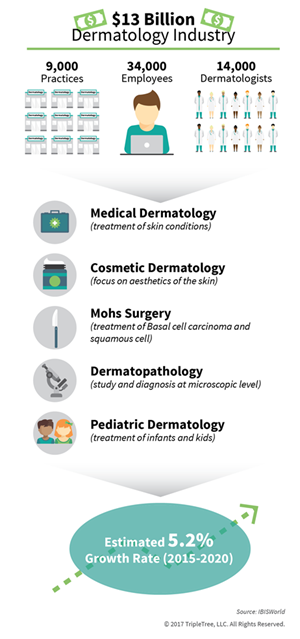Healthcare Services Insights
Dermatology: An Industry Poised for Continued Evolution, Innovation and Growth
April 20, 2017
The dermatology industry is estimated to be a $13 billion industry that is growing due to accelerated demand and robust industry trends. Practice management companies supporting dermatology practices are also on the rise, with significant investment and innovation around new management and operational models. In this blog, TripleTree reviews the factors and market tailwinds that support the acceleration of the dermatology industry as a whole, and of practice management penetration in the sector.

Growth in the Dermatology Industry
- Reimbursement Outlook is Attractive and Stable. Dermatologists are currently the third highest paid specialists, with only orthopedists and cardiologists earning more. This is supported by a strong reimbursement environment and significant out-of-pocket, consumer-pay revenue. This is not to say that dermatology reimbursement and revenues haven’t faced scrutiny. Beginning in 2007, under CMS’s Multiple Procedure Payment Reduction policy, subsequent surgical procedures performed during a session by the same physician received a 50% reimbursement cut. In addition, in 2013 CMS instituted several major reimbursement cuts to some of the most common dermatology procedures, such as the code for the most common pathology procedure and a code for complex closures on the face, seriously impacting total revenue. However, most industry observers believe that these reimbursement cuts signal future reimbursement stability, with greater confidence that CMS is unlikely to make significant additional reductions.
- High Margin, High Demand Cosmetic Procedures and Products. Medical ailments continue to be the major business driver for a dermatologist’s practice. Additionally, a growing number of empowered healthcare consumers, who are concerned about their image and are increasingly demanding more value for their dollar, are fueling business growth into new areas. To meet these new demands, dermatologists have continuously offered more and higher-margin cosmetic procedures. With few exceptions, these procedures — such as Botox injections, soft tissue fillers, chemical peels, and laser hair removal — are cosmetic in nature, are paid for entirely out-of pocket, and are minimally invasive, typically making them quite lucrative. In addition to cosmetic procedures, cosmeceutical products (products with biologic ingredients offering medical or pharmaceutical benefits) have also become quite popular, supporting an annual $5.9 billion in sales. These products are sold directly to dermatologists by pharmaceutical companies for sale in the dermatologist’s office. Many large, sophisticated practices and practice management-led organizations are leaders in identifying higher quality and innovative products, as well as in becoming leading distributors in their respective markets.
- The Aging Population and the Prevalence of Skin Cancer. The aging population is a trend with exceptional relevance to dermatology. As of 2014, 42% of dermatology patients were over the age of 60, a trend that will continue to increase until 2030. By 2019, there will be 54 million Americans over the age of 65, up from 46 million in 2014. A large portion of the potential dermatology practice success in this age demographic has to do with skin cancer, the most common form of cancer, with one in five Americans now poised to develop skin cancer in their lifetimes. About 50% of individuals who live to age 65 will develop either basal cell carcinoma or squamous cell carcinoma. That said, the average age of diagnosis for melanoma is 52, and the incidence is rising faster than any form of cancer. This growth has sparked a preventive and vigilant mentality in aging individuals; as a result, the U.S. market for skin disease treatment totaled $7.5 billion in 2015, and is expected to reach $8.6 billion by 2020.
Growth in Practice Management
- Consumer-Centric Approaches in Focus in Dermatology. The need for sophisticated marketing and engagement tactics has become more imperative than ever for dermatology practices, as dermatology is one of the most consumer-centric areas in healthcare. In response, practice management organizations have more heavily utilized technologies to improve their ability to attract, retain, and engage patients. These capabilities also act as lucrative upsell opportunities.
- A Shortage of Specialists. Another defining reason for the growth in dermatology demand is a general shortage in the number of practicing dermatologists, whose numbers have not adequately kept up with the high levels of demand that the industry has historically seen. With only 13,847 active dermatologists in the U.S., most patients who have tried to schedule an appointment can attest to the seemingly limited supply. In addition, new dermatologists are being trained at a low rate, with just 399 dermatology residency positions being offered in 2016. With such a small supply and such high demand for services, it should come as no surprise that dermatology practices remain busy and margins remain high.
- Increasing Physician Preference to be a Part of a Larger Organization. Dermatologists, among many other specialists across healthcare, are increasingly looking to be part of a larger organization and/or avoid the economic realities of starting and managing a successful dermatology practice. Heavier industry regulation, expensive startup costs, increasingly painful overhead costs, looming amounts of medical student debt, and extensive competition have made it near-impossible to operate a solo practice unless the individual already has an exceptional track record and a loyal book of patients.
TripleTree’s Perspective
With a clearly defined business model and a solid track record of success, the dermatology industry and the practice management companies that support it are poised to evolve, innovate, and thrive. Read more about dermatology’s accelerating momentum in our recent Industry Perspective, Practice Management 2.0. In the meantime, we welcome your perspectives and thoughts.




